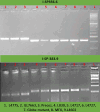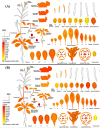Genome-wide discovery of InDels and validation of PCR-Based InDel markers for earliness in a RIL population and genotypes of lentil (Lens culinaris Medik.)
- PMID: 38776345
- PMCID: PMC11111061
- DOI: 10.1371/journal.pone.0302870
Genome-wide discovery of InDels and validation of PCR-Based InDel markers for earliness in a RIL population and genotypes of lentil (Lens culinaris Medik.)
Abstract
The systematic identification of insertion/deletion (InDel) length polymorphisms from the entire lentil genome can be used to map the quantitative trait loci (QTL) and also for the marker-assisted selection (MAS) for various linked traits. The InDels were identified by comparing the whole-genome resequencing (WGRS) data of two extreme bulks (early- and late-flowering bulk) and a parental genotype (Globe Mutant) of lentil. The bulks were made by pooling 20 extreme recombinant inbred lines (RILs) each, derived by crossing Globe Mutant (late flowering parent) with L4775 (early flowering parent). Finally, 734,716 novel InDels were identified, which is nearly one InDel per 5,096 bp of lentil genome. Furthermore, 74.94% of InDels were within the intergenic region and 99.45% displayed modifier effects. Of these, 15,732 had insertions or deletions of 20 bp or more, making them amenable to the development of PCR-based markers. An InDel marker I-SP-356.6 (chr. 3; position 356,687,623; positioned 174.5 Kb from the LcFRI gene) was identified as having a phenotypic variance explained (PVE) value of 47.7% for earliness when validated in a RIL population. Thus, I-SP-356.6 marker can be deployed in MAS to facilitate the transfer of the earliness trait to other elite late-maturing cultivars. Two InDel markers viz., I-SP-356.6 and I-SP-383.9 (chr. 3; linked to LcELF3a gene) when tested in 9 lentil genotypes differing for maturity duration, clearly distinguished three early (L4775, ILL7663, Precoz) and four late genotypes (Globe Mutant, MFX, L4602, L830). However, these InDels could not be validated in two genotypes (L4717, L4727), suggesting either absence of polymorphism and/or presence of other loci causing earliness. The identified InDel markers can act as valuable tools for MAS for the development of early maturing lentil varieties.
Copyright: © 2024 Shivaprasad et al. This is an open access article distributed under the terms of the Creative Commons Attribution License, which permits unrestricted use, distribution, and reproduction in any medium, provided the original author and source are credited.
Conflict of interest statement
The authors have declared that no competing interests exist.
Figures





Similar articles
-
Delineation of loci governing an extra-earliness trait in lentil (Lens culinaris Medik.) using the QTL-Seq approach.Plant Biotechnol J. 2024 Oct;22(10):2932-2949. doi: 10.1111/pbi.14415. Epub 2024 Jun 25. Plant Biotechnol J. 2024. PMID: 38923713 Free PMC article.
-
Morpho-biochemical characterization of a RIL population for seed parameters and identification of candidate genes regulating seed size trait in lentil (Lens culinaris Medik.).Front Plant Sci. 2023 Feb 15;14:1091432. doi: 10.3389/fpls.2023.1091432. eCollection 2023. Front Plant Sci. 2023. PMID: 36875597 Free PMC article.
-
Construction of a high-density interspecific (Lens culinaris x L. odemensis) genetic map based on functional markers for mapping morphological and agronomical traits, and QTLs affecting resistance to Ascochyta in lentil.PLoS One. 2019 Mar 27;14(3):e0214409. doi: 10.1371/journal.pone.0214409. eCollection 2019. PLoS One. 2019. PMID: 30917174 Free PMC article.
-
Development and Validation of SNP and InDel Markers for Pod-Shattering Tolerance in Soybean.Int J Mol Sci. 2022 Feb 21;23(4):2382. doi: 10.3390/ijms23042382. Int J Mol Sci. 2022. PMID: 35216500 Free PMC article.
-
Identification of genomic regions associated with early plant vigour in lentil (Lens culinaris).J Genet. 2020;99:21. J Genet. 2020. PMID: 32366732
Cited by
-
Chloroplast genome comparison and taxonomic reassessment of Polygonatum sensu Lato (Asparagaceae): implications for molecular marker development in traditional medicinal plants.BMC Genomics. 2025 Sep 2;26(1):796. doi: 10.1186/s12864-025-12012-y. BMC Genomics. 2025. PMID: 40898047 Free PMC article.
-
Identification of Insertion and Deletion (InDel) Markers for Chickpea (Cicer arietinum L.) Based on Double-Digest Restriction Site-Associated DNA Sequencing.Plants (Basel). 2024 Sep 9;13(17):2530. doi: 10.3390/plants13172530. Plants (Basel). 2024. PMID: 39274014 Free PMC article.
References
-
- Mishra GP, Dikshit HK, Kumari J, Priti, Tripathi K, Devi J, et al.. Identification and characterization of novel penta‐podded genotypes in the cultivated lentil. Crop Science. 2020; 60(4):1974–85. 10.1002/csc2.20156. - DOI
-
- FAOSTAT statistical database. Food and Agriculture Organization of the United Nations. 2020. https://www.fao.org/faostat/en/#home.
-
- Bhatty R. Composition and quality of lentil (Lens culinaris Medik): a review. Canadian Institute of Food Science and Technology Journal. 1988; 21(2):144–60. 10.1016/S0315-5463(88)70770-1. - DOI
-
- Summerfield R, Roberts E, Erskine W, Ellis R. Effects of temperature and photoperiod on flowering in lentils (Lens culinaris Medik.). Annals of Botany. 1985; 56(5):659–71. 10.1093/oxfordjournals.aob.a087055. - DOI
-
- Dutta H, KM S, Aski MS, Mishra GP, Sinha SK, Vijay D, et al.. Morpho-biochemical characterization of a RIL population for seed parameters and identification of candidate genes regulating seed size trait in lentil (Lens culinaris Medik.). Frontiers in Plant Science. 2023; 14:1091432. 10.3389/fpls.2023.1091432. - DOI - PMC - PubMed
MeSH terms
Substances
LinkOut - more resources
Full Text Sources

